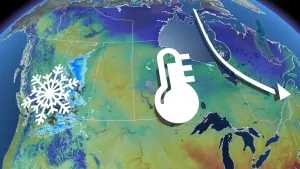
Toronto police warn of falling ice
Here's how you can help avoid ice-related incidents.
Toronto police received several calls about falling ice in Toronto's downtown core Tuesday morning, as sun-heated surfaces caused the ice that formed during Sunday's storm to loosen.
Just before 11 a.m., Toronto Police Operations tweeted that officers were responding to reports of ice from construction cranes, buildings, and other tall structures.
A section of Bay Street was temporarily closed, and some buses were delayed or detoured due to the ice, Global News reports.
Drivers and pedestrians being asked to remain diligent on the road and prepare for the possibility of falling ice.
Here are some tips to keep safe
BE AWARE: SHEETS OF ICE COULD FLY OFF TRANSPORT TRUCKS AND OVERPASSES
Ice flying off of a vehicle or overpass is always a hazard, during and in the days following an ice event Sgt. Schmidt tells The Weather Network.
While there isn't a lot you can do to avoid it at the moment, Schmidt says it's important to be proactive.
"[Ice] can become a flying projectile once you hit highway speed ... and the vehicles behind you really have no chance to avoid it," he says, adding there's no law that requires transport truck operators to clear the ice off their trucks.
The best way to mitigate risks on the roads is to keep a safe distance behind other vehicles and be aware of your surroundings. But sometimes, falling ice is unavoidable.
Check out the damage a falling chunk of ice inflicted on an unoccupied vehicle in New York in February 2017:
PEDESTRIANS: KEEP YOUR EYES TO THE SKY, BUT WATCH WHERE YOU WALK
When you're walking outside, pay attention to what's above you. "If you're walking under any structure -- crosswalk, overpass, bridge, etc. -- where there may be ice or water or icicles handing down from above, just be careful," Schmidt says.
Another thing to keep in mind: Any partially-melted ice coating the ground will be extra slippery.
There were nearly 9,000 hospitalizations due to falls on ice in Canada in 2016-2017, making them the number-one cause of sport or winter injuries, according to the Canadian Institute for Health Information.
Wear shoes with good grips, take your time, and being aware of your surroundings to help avoid accidents.
WIND AND SUN CAN EXACERBATE THE ISSUE
It doesn't take a lot of wind to dislodge ice and transport it to a wider area.
And here's something else to keep in mind: The sun doesn't have to feel warm to melt the ice.
When sun shines on ice, it absorbs UV rays that can cause it to warm and melt, even if the temperature is chilly.
Other objects -- like trees or buildings -- can warm up even more and accelerate ice melt which can, in turn, cause pieces to fall.
BEWARE OF PREVIOUSLY-FROZEN BODIES OF WATER
No ice is safe ice, according to Sgt. Schmidt, and that's especially true after a warm-up.
Previously-frozen bodies of water should be treated with extreme caution or outright avoided. If you'll be venturing near a large body of ice, consider bringing ice picks and don't go alone. Make sure there's someone on land who can keep track of you.
Thawing ice also presents the risk of flooding on roadways, in parks and on streets.
Thumbnail image: UGC/uploaded to The Weather Network










